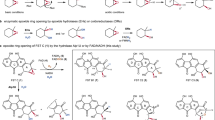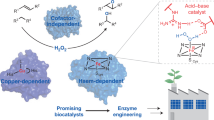Abstract
One of the hallmark reactions catalyzed by flavin-dependent enzymes is the incorporation of an oxygen atom derived from dioxygen into organic substrates. For many decades, these flavin monooxygenases were assumed to use exclusively the flavin-C4a-(hydro)peroxide as their oxygen-transferring intermediate. We demonstrate that flavoenzymes may instead employ a flavin-N5-peroxide as a soft α-nucleophile for catalysis, which enables chemistry not accessible to canonical monooxygenases. This includes, for example, the redox-neutral cleavage of carbon-hetero bonds or the dehalogenation of inert environmental pollutants via atypical oxygenations. We furthermore identify a shared structural motif for dioxygen activation and N5-functionalization, suggesting a conserved pathway that may be operative in numerous characterized and uncharacterized flavoenzymes from diverse organisms. Our findings show that overlooked flavin-N5-oxygen adducts are more widespread and may facilitate versatile chemistry, thus upending the notion that flavin monooxygenases exclusively function as nature’s equivalents to organic peroxides in synthetic chemistry.
This is a preview of subscription content, access via your institution
Access options
Access Nature and 54 other Nature Portfolio journals
Get Nature+, our best-value online-access subscription
$29.99 / 30 days
cancel any time
Subscribe to this journal
Receive 12 print issues and online access
$259.00 per year
only $21.58 per issue
Buy this article
- Purchase on Springer Link
- Instant access to full article PDF
Prices may be subject to local taxes which are calculated during checkout





Similar content being viewed by others
Data availability
All data generated or analyzed during this study are included in this published article (and its Supplementary information files). The structures for proteins described in this paper have been deposited in the PDB. The PDB accession codes are 6TEE for RutA under anaerobic conditions, 6TEF for RutA pressurized with 5 bars O2, 6SGG for RutA pressurized with 15 bars O2, 6SGL for RutA in complex with uracil, 6SGM for RutA in complex with 4-thiouracil, 6SGN for RutA in complex with 2,4-dimethoxy pyrimidine and 6TEG for RutA in complex with uracil pressurized with 15 bars O2.
References
Walsh, C. T. & Wencewicz, T. A. Flavoenzymes: versatile catalysts in biosynthetic pathways. Nat. Prod. Rep. 30, 175–200 (2013).
Heine, T., van Berkel, W. J. H., Gassner, G., van Pée, K.-H. & Tischler, D. Two-component FAD-dependent monooxygenases: current knowledge and biotechnological opportunities. Biol. 7, pii: E42 (2018).
Teufel, R. Flavin-catalyzed redox tailoring reactions in natural product biosynthesis. Arch. Biochem. Biophys. 632, 20–27 (2017).
Teufel, R., Agarwal, V. & Moore, B. S. Unusual flavoenzyme catalysis in marine bacteria. Curr. Opin. Chem. Biol. 31, 31–39 (2016).
Massey, V. Activation of molecular oxygen by flavins and flavoproteins. J. Biol. Chem. 269, 22459–22462 (1994).
Ewing, T. A., Fraaije, M. W., Mattevi, A. & van Berkel, W. J. H. The VAO/PCMH flavoprotein family. Arch. Biochem. Biophys. 632, 104–117 (2017).
Macheroux, P., Kappes, B. & Ealick, S. E. Flavogenomics—a genomic and structural view of flavin-dependent proteins. FEBS J. 278, 2625–2634 (2011).
Palfey, B. A. & McDonald, C. A. Control of catalysis in flavin-dependent monooxygenases. Arch. Biochem. Biophys. 493, 26–36 (2010).
Chaiyen, P., Fraaije, M. W. & Mattevi, A. The enigmatic reaction of flavins with oxygen. Trends Biochem. Sci. 37, 373–380 (2012).
Fraaije, M. W. & Mattevi, A. Flavoenzymes: diverse catalysts with recurrent features. Trends Biochem. Sci. 25, 126–132 (2000).
Mattevi, A. To be or not to be an oxidase: challenging the oxygen reactivity of flavoenzymes. Trends Biochem. Sci. 31, 276–283 (2006).
Huijbers, M. M. E., Montersino, S., Westphal, A. H., Tischler, D. & van Berkel, W. J. H. Flavin dependent monooxygenases. Arch. Biochem. Biophys. 544, 2–17 (2014).
Ellis, H. R. The FMN-dependent two-component monooxygenase systems. Arch. Biochem. Biophys. 497, 1–12 (2010).
Adak, S. & Begley, T. P. RutA-catalyzed oxidative cleavage of the uracil amide involves formation of a flavin-N5-oxide. Biochemistry 56, 3708–3709 (2017).
Loh, K. D. et al. A previously undescribed pathway for pyrimidine catabolism. Proc. Natl Acad. Sci. USA 103, 5114–5119 (2006).
Adak, S. & Begley, T. P. Dibenzothiophene catabolism proceeds via a flavin-N5-oxide intermediate. J. Am. Chem. Soc. 138, 6424–6426 (2016).
Davoodi-Dehaghani, F., Vosoughi, M. & Ziaee, A. A. Biodesulfurization of dibenzothiophene by a newly isolated Rhodococcus erythropolis strain. Bioresour. Technol. 101, 1102–1105 (2010).
Takagi, K. et al. Aerobic mineralization of hexachlorobenzene by newly isolated pentachloronitrobenzene-degrading Nocardioides sp. strain PD653. Appl. Environ. Microbiol. 75, 4452–4458 (2009).
Adak, S. & Begley, T. P. Hexachlorobenzene catabolism involves a nucleophilic aromatic substitution and flavin-N5-oxide formation. Biochemistry 58, 1181–1183 (2019).
Saleem-Batcha, R. & Teufel, R. Structural methods for probing the interaction of flavoenzymes with dioxygen and its surrogates. Methods Enzymol. 620, 349–363 (2019).
Colloc’h, N. et al. Oxygen pressurized X-ray crystallography: probing the dioxygen binding site in cofactorless urate oxidase and implications for its catalytic mechanism. Biophys. J. 95, 2415–2422 (2008).
Mukherjee, T., Zhang, Y., Abdelwahed, S., Ealick, S. E. & Begley, T. P. Catalysis of a flavoenzyme-mediated amide hydrolysis. J. Am. Chem. Soc. 132, 5550–5551 (2010).
Xiang, L., Kalaitzis, J. A. & Moore, B. S. EncM, a versatile enterocin biosynthetic enzyme involved in Favorskii oxidative rearrangement, aldol condensation, and heterocycle-forming reactions. Proc. Natl. Acad. Sci. 101, 15609–15614 (2004).
Saleem-Batcha, R. & Teufel, R. Insights into the enzymatic formation, chemical features, and biological role of the flavin-N5-oxide. Curr. Opin. Chem. Biol. 47, 47–53 (2018).
Teufel, R. Preparation and characterization of the Favorskiiase flavoprotein EncM and its distinctive flavin-N5-oxide cofactor. Methods Enzymol. 604, 523–540 (2018).
Teufel, R. et al. Flavin-mediated dual oxidation controls an enzymatic Favorskii-type rearrangement. Nature 503, 552–556 (2013).
Teufel, R. et al. Biochemical establishment and characterization of EncM’s flavin-N5-oxide cofactor. J. Am. Chem. Soc. 137, 8078–8085 (2015).
Saleem-Batcha, R. et al. Enzymatic control of dioxygen binding and functionalization of the flavin cofactor. Proc. Natl Acad. Sci. USA 115, 4909–4914 (2018).
Alfieri, A. et al. Structure of the monooxygenase component of a two-component flavoprotein monooxygenase. Proc. Natl Acad. Sci. USA 104, 1177–1182 (2007).
Batsanov, S. S. Van der Waals radii of elements. Inorg. Mater. 37, 871–885 (2001).
Liu, Y. et al. CB-Dock: a web server for cavity detection-guided protein-ligand blind docking. Acta Pharmacol. Sin. 41, 138–144 (2019).
Trott, O. & Olson, A. J. AutoDock Vina: improving the speed and accuracy of docking with a new scoring function, efficient optimization, and multithreading. J. Comput. Chem. 31, 455–461 (2010).
Klinman, J. P. How do enzymes activate oxygen without inactivating themselves? Acc. Chem. Res. 40, 325–333 (2007).
Edwards, J. O. & Pearson, R. G. The factors determining nucleophilic reactivities. J. Am. Chem. Soc. 84, 16–24 (1962).
Garver, J. M., Gronert, S. & Bierbaum, V. M. Experimental validation of the α-effect in the gas phase. J. Am. Chem. Soc. 133, 13894–13897 (2011).
Feng, L. et al. Genome and proteome of long-chain alkane degrading Geobacillus thermodenitrificans NG80-2 isolated from a deep-subsurface oil reservoir. Proc. Natl Acad. Sci. USA 104, 5602–5607 (2007).
Li, L. et al. Crystal structure of long-chain alkane monooxygenase (LadA) in complex with coenzyme FMN: unveiling the long-chain alkane hydroxylase. J. Mol. Biol. 376, 453–465 (2008).
Wentzel, A., Ellingsen, T. E., Kotlar, H.-K., Zotchev, S. B. & Throne-Holst, M. Bacterial metabolism of long-chain n-alkanes. Appl. Microbiol. Biotechnol. 76, 1209–1221 (2007).
Austin, R. N. & Groves, J. T. Alkane-oxidizing metalloenzymes in the carbon cycle. Metallomics 3, 775–787 (2011).
Ishii, Y., Iwahama, T., Sakaguchi, S., Nakayama, K. & Nishiyama, Y. Alkane oxidation with molecular oxygen using a new efficient catalytic system: N-hydroxyphthalimide (NHPI) combined with Co(acac)n (n = 2 or 3). J. Org. Chem. 61, 4520–4526 (1996).
Petrosyan, A., Hauptmann, R. & Pospech, J. Heteroarene N-oxides as oxygen source in organic reactions. Eur. J. Org. Chem. 2018, 5237–5252 (2018).
Shashin, S. S. & Rykova, E. A. Oxidation of organic amide ions by molecular oxygen: structure and properties of possible intermediates. J. Mol. Struct. 311, 175–183 (1994).
Kabsch, W. XDS. Acta Crystallogr. D. 66, 125–132 (2010).
Evans, P. Scaling and assessment of data quality. Acta Crystallogr. D. 62, 72–82 (2006).
McCoy, A. J. et al. Phaser crystallographic software. J. Appl. Crystallogr. 40, 658–674 (2007).
Murshudov, G. N. et al. REFMAC5 for the refinement of macromolecular crystal structures. Acta Crystallogr. D. 67, 355–367 (2011).
Adams, P. D. et al. PHENIX: a comprehensive Python-based system for macromolecular structure solution. Acta Crystallogr. D. 66, 213–221 (2010).
Emsley, P. & Cowtan, K. Coot: model-building tools for molecular graphics. Acta Crystallogr. D. 60, 2126–2132 (2004).
Liebschner, D. et al. Polder maps: improving OMIT maps by excluding bulk solvent. Acta Crystallogr. D. 73, 148–157 (2017).
Chen, V. B. et al. MolProbity: all-atom structure validation for macromolecular crystallography. Acta Crystallogr. D. 66, 12–21 (2010).
Moran, G. R. Anaerobic methods for the transient-state study of flavoproteins: the use of specialized glassware to define the concentration of dioxygen. Methods Enzymol. 620, 27–49 (2019).
Wallingford, C. T. Gaussian 09, Revision D.01 (Gaussian, Inc., 2016).
Zhao, Y. & Truhlar, D. G. The M06 suite of density functionals for main group thermochemistry, thermochemical kinetics, noncovalent interactions, excited states, and transition elements: two new functionals and systematic testing of four M06-class functionals and 12 other functionals. Theor. Chem. Acc. 120, 215–241 (2008).
Miertuš, S., Scrocco, E. & Tomasi, J. Electrostatic interaction of a solute with a continuum. A direct utilization of ab initio molecular potentials for the prevision of solvent effects. Chem. Phys. 55, 117–129 (1981).
Miertus̃, S. & Tomasi, J. Approximate evaluations of the electrostatic free energy and internal energy changes in solution processes. Chem. Phys. 65, 239–245 (1982).
Pascual-ahuir, J. L., Silla, E. & Tuñon, I. GEPOL: an improved description of molecular surfaces. III. A new algorithm for the computation of a solvent-excluding surface. J. Comput. Chem. 15, 1127–1138 (1994).
Acknowledgements
This work was supported by the Deutsche Forschungsgemeinschaft (DFG) by grant nos. TE 931/2–1 (awarded to R.T.) and 235777276/GRK1976 (R.T.) as well as the National Institute of General Medical Sciences and of the National Institutes of Health under Award Number F32GM122218 (J.N.S.). Computational resources were provided by the UCLA Institute for Digital Research and Education. We thank M. Boll, B. Palfey, C. Fanhi, B. Kammerer and S. Lagies for technical support.
Author information
Authors and Affiliations
Contributions
A.M. conducted gene cloning, heterologous expression, protein purification, enzyme mutagenesis, all mechanistic enzyme studies and their analysis as well as docking simulations. R.S-B. conducted and analyzed all X-ray crystallography experiments. F.S. conducted stopped-flow spectroscopy and wrote this section. J.N.S. and K.N.H. planned and performed the computations and wrote this section. R.T. planned and analyzed the experiments and wrote the manuscript. A.M., R.S-B. and J.N.S. contributed equally to the work.
Corresponding author
Ethics declarations
Competing interests
The authors declare no competing interests.
Additional information
Publisher’s note Springer Nature remains neutral with regard to jurisdictional claims in published maps and institutional affiliations.
Supplementary information
Supplementary Information
Supplementary Tables 1–4, Figs. 1–13 and Notes.
Rights and permissions
About this article
Cite this article
Matthews, A., Saleem-Batcha, R., Sanders, J.N. et al. Aminoperoxide adducts expand the catalytic repertoire of flavin monooxygenases. Nat Chem Biol 16, 556–563 (2020). https://doi.org/10.1038/s41589-020-0476-2
Received:
Accepted:
Published:
Issue Date:
DOI: https://doi.org/10.1038/s41589-020-0476-2
This article is cited by
-
Enzymatic spiroketal formation via oxidative rearrangement of pentangular polyketides
Nature Communications (2021)
-
Flavin doesn’t put all oxygens in one basket
Nature Chemical Biology (2020)



